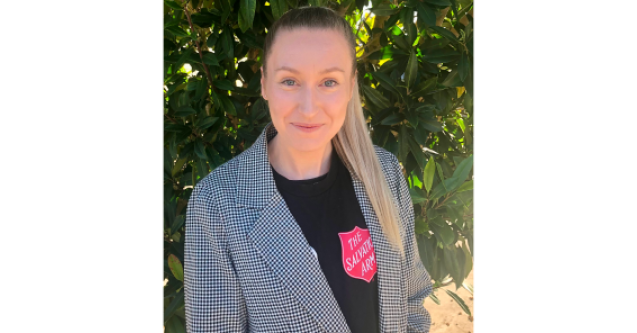Are you financially prepared for a natural disaster?
11 December 2024

After volunteering in disaster recovery, Cassie from Moneycare realised the importance of reviewing her own insurance and disaster planning.
Summer in Australia, for many, is a time for barbecues, beaches (or rivers), holidays, and heat. Unfortunately, it’s also a season often marked by floods, fires, and other devastating natural disasters somewhere in the country. So, are you financially prepared for a disaster? How do you even get ready? How can you expect the unexpected and plan for the unplanned?
The Salvation Army Moneycare team addresses a range of scenarios and questions about being financially and emotionally prepared for a natural disaster in their free eBook, Planning for the Unplanned. This guide provides tips, tricks and checklists for disaster preparation, along with a variety of compelling personal stories.
While each story is unique, a common theme emerges from interviews with people who have faced disasters and disaster recovery: the importance of reviewing areas such as insurance, having emergency savings, staying calm during chaos, and maintaining strong social connections for mental and emotional health.
The importance of preparing for disaster
Cassie – a caring member of The Salvation Army Moneycare team – features in Planning for the Unplanned. Several years ago, she helped support those severely affected by floods, but nothing could have prepared her for the devastation she witnessed while driving to the Lowood (Qld) Recovery Centre. It was beyond anything she could have imagined.
“I saw the forest was bent,” she said. “To stand there and look at all these trees bent from the force and see the water up to the roof of someone’s house — it really hits home how much devastation the floods caused. You see it on TV, but you don’t realise the power behind it.”
Inside the recovery centre, Cassie came face-to-face with people whose lives had been torn apart. “There were really hard days where I just had people sitting in front of me who lost everything,” she said. Many older farmers — who were used to being strong and independent — found themselves broken and vulnerable.
“Quite a lot of the farmers broke down because they thought they were fine, they didn’t need the help, but then they’re sitting in front of me in tears.”
Cassie’s experience at the flood recovery centre profoundly shaped her outlook on financial preparedness. Seeing firsthand the devastating impacts of disaster made her realise how easily everything can be lost and how important it is to be as prepared as possible.
After returning home from the recovery centre, she said, “I had a look at the flood ratings for my house. I went through my insurance to make sure I was covered for floods, fires, natural disasters. I know it can take 18 to 24 months to rebuild a house. My insurance covers accommodation costs for some time, but would there be accommodation available near school? Would we have to change schools?”
She added, “Financially, I think I’d be ready, but emotionally, I know I’d rely on family support. I guess you don’t really know how prepared you are until you go through it.”
Download our free eBook Planning for the Unplanned for more tips on preparing for a disaster.
How to plan for the unplanned
While you can never fully prepare for a disaster, there are essential steps to take to protect yourself financially and be ready for the unexpected. Emergency savings are key, as is safeguarding important documents and belongings.
Here are some steps to consider:
- Protect your important documents: Keep all essential documents in a safe, easily accessible bag made of fireproof and water-resistant material. Additionally, consider storing documents on an external hard drive, in cloud storage, or emailing them to yourself.
Some crucial documents include: - Copies of council rates, rental agreements, and utilities
- Birth and marriage certificates
- Passport, visa, and citizenship papers
- Driver’s licence and Medicare card
- Will and estate information
- Medical information and prescriptions
- Photo identification
- Qualifications and insurance documents
- Photos of your property with date stamps
- Bank statements, tax returns and superannuation documents
- Mortgage documents or rental agreements
- Emergency contacts and cash
- Phone chargers and spare clothing
- Identify and protect your most cherished items: Plan to take or protect your most cherished items in case you need to leave your home quickly. Photograph sentimental items, such as family heirlooms, including any maker’s marks and serial numbers. Store these images electronically for easy access, whether for replacement or insurance purposes.
- Make sure you are insured and review regularly: Essential insurances include, but are not limited to:
- Home building insurance: Essential for homeowners to cover damage to property. Check what the policy covers and use an online calculator to determine the necessary coverage amount.
- Contents insurance: Useful for both homeowners and renters to cover household items. Verify what’s covered and whether the valuation is on a “replacement” or “new for old” basis.
- Motor vehicle insurance: Includes Compulsory Third Party (CTP), Comprehensive Insurance, and Third-Party Property. Choose the coverage that suits your needs, considering additional features like theft.
Facing the future with confidence
Financial preparedness for a disaster goes beyond just having money in the bank — it’s about creating a plan that protects your future, your wellbeing, and your peace of mind. With the right combination of insurance, emergency funds, and a clear strategy, you can approach the unexpected with greater confidence.
Equally important are the emotional and social networks that provide strength in times of chaos. By learning from the experiences of others and taking proactive steps now, you can prepare for the unplanned and face disasters with at least a measure of resilience and readiness.